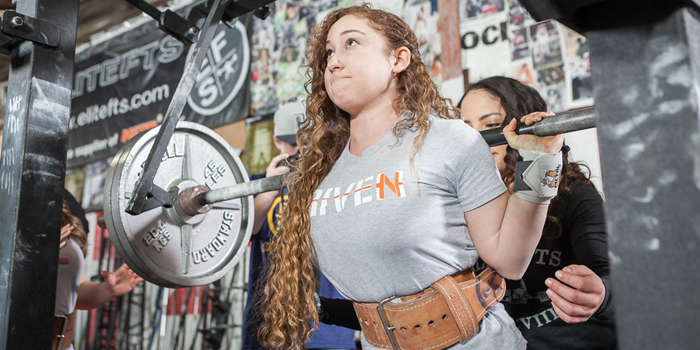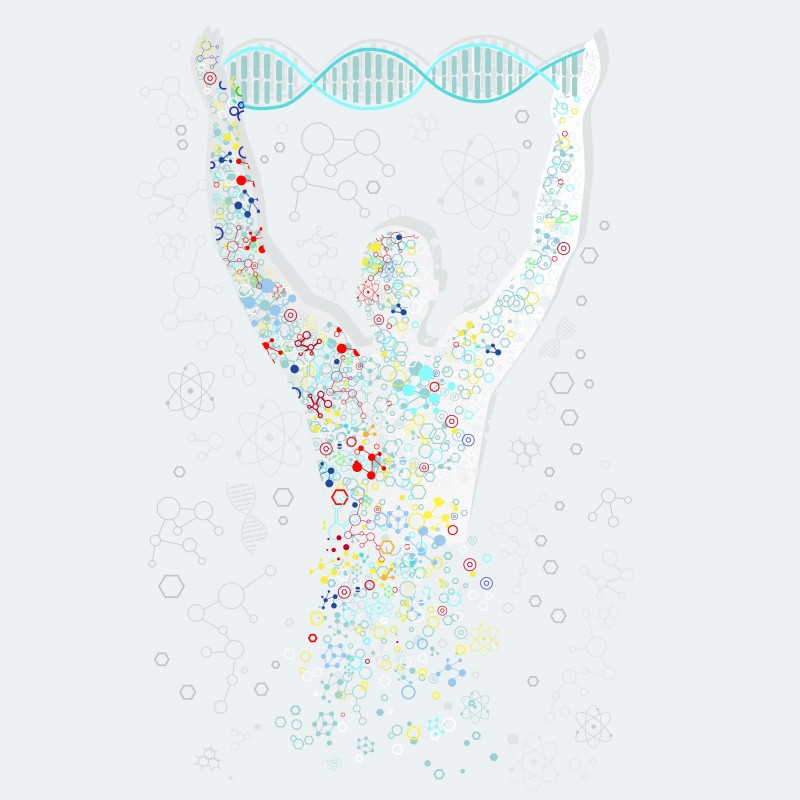
It’s pretty accepted that people respond differently to training. However, it’s pretty under-appreciated how the variations in ones’ genetic makeup profoundly influences their responsiveness to different types of training. I think we can all agree that genes are essential. They are your chemical blueprint and dictate how you look, how you function, and how you perform. We all share about 99.9% of the same genes, but it's the 0.1% that makes us unique. To put it in perspective, a genetic difference of 4% is what separates us from chimps, and a genetic difference of 10% is what separates us from cats.
RECENT: Antioxidants and Adaptations: Do You Need Free Radicals to Get Hulky?
So, when you look at it from that perspective, I’m sure you can understand why differences in 0.1% of our genes result in a lot of diversity between us members of the human race. It just takes a modification in one gene to make you more likely to sprint faster than me, or for me to be more likely to be fatter than you.
Can minor genetic differences make major differences?
For example, in some people the gene FTO (fat mass and obesity associated gene) have mutations near the beginning of its sequence. The presence of these mutations in one or both copies of the gene makes people susceptible to becoming obese, weighing more, or eating more1. ACTN3 (Alpha-actinin-3) is another gene, and a variation in its sequence3 can determine if you’re more likely to have better or worse power performance. And why is that? Because ACTN3 makes a protein found in your fast-twitch fibers that is highly important for their ability to generate force at high velocities. Thus, with one version of ACTN3, you make the fully functional version of this protein and all is good. However, with a very specific change in the sequence of this gene, the ability of the gene to code for a full-length version of the ACTN3 protein is hindered, as is your ability to be as powerful as someone whose type II fibers make the full-length version of the protein.
So, as you can see, small changes to the sequence of just one gene can have an effect on your ability to adapt to diet and training. Keep in mind, in the human genome there is something like 30,000 protein-making genes and something like 84.7 million gene variants3. Let that sink in: there are millions of known gene variants, but the presence of just one can have an effect on human health and performance.
Genes matter, but does genetic testing?
We know the genes you inherit from your parents strongly influence things like muscle mass4, fat mass, height5, weight, and fiber size distribution6. So, I think it’s safe to make a bold statement and say that genes matter when it comes to your ability to respond to training. But what about genetic testing? Does it matter or make a difference in the context of using it as a tool to design training programs that you will respond best to?
In the most simple of terms, genetic testing is the process of sending off your saliva swab (hair, skin, or blood) and getting back information on the sequences of your genes. This information can tell you if any of these sequences have variants or mutation, and that information can be used for critical and life-changing things like identifying genetic disorders or paternal testing. However, it can also be used to understand how your genes contribute to your ability to be fit, fat, functional, or freaky (from an athletic standpoint). Some companies search many genes and give you information about your ancestry, family history, and health risks. Other more performance-based companies do targeted searches where they look specifically at the sequences of your genes involved in regulating muscle fitness, function, and metabolism, and then provide suggestions on how you can use that information to modify your diet and training. But is it worth it to fork $100 or $300 to get this information?
MORE: Are Your Genetics Holding You Back?
A super cool study in 2016 argued yes7. Aiming to understand if genetic testing could be used to optimize training protocols for athletes, a group in the UK looked at 15 power and endurance associated gene variants in athletes. Using genetic profiling, they grouped the athletes by their genetic profiles into either having power-related genes (power-related genotype group) or having endurance-related genes (endurance-related genotype group). For each genotype group, half the athletes trained on using 30% one-rep max for high rep sets and the other half used 70% one-rep max for lower rep sets. After eight weeks of training, they found that matching one’s genetic profile to their training protocol basically tripled their training adaptations. Hence, the power-genotype athletes on the strength program increased their power output more than the ones on the endurance program, and the endurance-genotype athletes on the endurance program increased their endurance more than the ones on the strength program.
It wasn’t a perfect study (I mean, are any really ever perfect?), but it did leave behind a pretty cool message that by training for your genotype (your genetic traits), you can improve your ability to respond to exercise. Additionally, it pointed out how the wrong program for your genotype can limit your ability to respond maximally to training.
To swab or not to swab?
I think that if you spend the money to do genetic testing, you can absolutely get some information about your genetic potential as a power or endurance athlete. I’m not sure if it’s as helpful for those who are strength or size athletes, as it is much less clear which genetic variants influence muscle strength and hypertrophy (excluding what we know about myostatin mutations8,9). In fact, it’s been shown that it’s the combination of 22 different genetic variants that can predispose you to being stronger10. Sadly, the chances of you having the beneficial version of all 22 of those genes are in the trillions, so you probably don’t need to pay to find out you’re not the lucky one. And for that one exception, you probably already knew you were it based on how you look and perform.
But that being said, even if you were one in two trillion to have all 22 “good” variants of the “strong genes,” that still doesn't mean you will end up with an Olympic medal. In the history of athletics, there have been many non-genetic outliers that have risen to the top, and many genetic outliers that have sunk to the bottom. A genetic profile is by no means a way to bypass putting in the time and training to become elite. Genetic profiles can tell you where you have an advantage, where you have a disadvantage, and can allow you to organize your training a bit smarter.
At the end of the day, for someone who's just starting training, I’m not sure you need to get genetic testing to make positive adaptations and gains in response to training. I do think for those who have hit plateaus or for those who are highly trained, there can be some value to obtaining a genetic test. It can help you understand if you need to tweak your training to better suit your genotype and it can help you figure out what type of training you might best respond to. Your genes are your blueprint, and genetic testing is just another tool you can use to better organize and optimize your training.
References
- Loos, R.J. & Yeo, G.S. The bigger picture of FTO: the first GWAS-identified obesity gene. Nature reviews. Endocrinology 10, 51-61 (2014).
- Yang, N. et al. ACTN3 genotype is associated with human elite athletic performance. American journal of human genetics 73, 627-631 (2003).
- Genomes Project, C. et al. A global reference for human genetic variation. Nature 526, 68-74 (2015).
- Arden, N.K. & Spector, T.D. Genetic influences on muscle strength, lean body mass, and bone mineral density: a twin study. Journal of bone and mineral research: the official journal of the American Society for Bone and Mineral Research 12, 2076-2081 (1997).
- Silventoinen, K. et al. Heritability of adult body height: a comparative study of twin cohorts in eight countries. Twin research: the official journal of the International Society for Twin Studies 6, 399-408 (2003).
- Simoneau, J.A. & Bouchard, C. Genetic determinism of fiber type proportion in human skeletal muscle. FASEB journal: official publication of the Federation of American Societies for Experimental Biology 9, 1091-1095 (1995).
- Monnerat-Cahli, G. et al. Letter to the editor: Are the doors opened to a genetic-based algorithm for personalized resistance training? Biology of sport 34, 27-29 (2017).
- Schuelke, M. et al. Myostatin mutation associated with gross muscle hypertrophy in a child. The New England journal of medicine 350, 2682-2688 (2004).
- Mosher, D.S. et al. A mutation in the myostatin gene increases muscle mass and enhances racing performance in heterozygote dogs. PLoS genetics 3, e79 (2007).
- Hughes, D.C., Day, S.H., Ahmetov, II & Williams, A.G. Genetics of muscle strength and power: polygenic profile similarity limits skeletal muscle performance. Journal of sports sciences 29, 1425-1434 (2011).
Image credit: robuart © 123rf.com












1 Comment